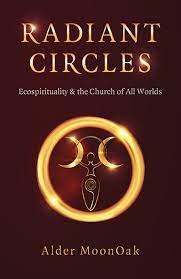Among the many neo-pagan groups that arose out of the spiritual countercultures of the 1960s and 1970s, one of the most enduring and colorful has been the Church of All Worlds (CAW). The Church of all Worlds began as the brain child of two college students, Tim Zell and Lance Christie, in the early 1960s. They’d read Robert Heinlein’s science fiction book Stranger in a Strange Land and wanted to form a group based on it, and each did form an organization. This was in the midst of the emerging hippie scene which had grown out of the 1950s Beat subculture. Eventually, Zell changed his name to Oberon Zell. (Most recently, he has retired at age 80 as the headmaster of the online Grey School of Wizardry.) It was Zell who coined the term Gaia Thesis, proposing that the planet Earth is a conscious, intelligent being. His late wife Morninglory Zell is said to have coined the term polyamory, a relationship practice associated with CAW.
Author Alder MoonOak has been a participant-observer within CAW since 1990. He’s one of its priests and an editor of its Green Egg magazine. He’s also a professor of religion and philosophy at the College of Central Florida.
I was hoping for a colorful treatment of this unusual and long-lasting group. But instead what the reader finds is a staidly written academic treatise that is, nevertheless, a good read and an important contribution as a case study of what social movements scholars have called “new religious movements.” It’s an ethnography, though the word “ethnography” doesn’t appear until page 118, and it’s not until Chapter 3 that MoonOak really gets into describing the CAW.
Instead, the first part of the book is a long definitional treatise about ecospirituality and its philosophical roots. I learned that the word ecology comes from the Greek word for household, so tha ecology is the study of our household,Earth. “Ecospirituality,” MoonOak writes, “can be defined for our purposes as the confluence of planetary ecological holism and spiritual consciousness transcending human sensory perception (but not experience) into a meta-narrative wherein human and non-human worlds can take on deeply held import and are thus imbued with the ultimate value and consequently become worthy of protective care or even veneration.” For readers not academically trained or inclined, this kind of writing may be too much of a slog. I found interesting MoonOak’s discussion of something a religion professor colleague of his has termed Dark Green Religion, which has to do with the rise of Earth-based religions as one part of the solution to our environmental crises.
MoonOak himself got involved with the CAW after he was handed a copy of the Green Egg magazine. He says that even before he opened it, he felt he had found one of his spiritual homes. He’s trained, he writes, to “examine religions and spiritual traditions with the objectivity of analytics and detached inquiry.” And, he’s also totally into CAW. He says his perspective on CAW “emerges from personal experiences through gatherings, rituals, ‘sacred bullshit sessions,’ magical work and a sense of community engendered by the people attracted to this demure ‘grock flock.’” He writes about CAW members’ affinity for themes found in the Star Trek TV and movie series as well as the role of polyamory as part of the bonding that makes CAW, sociologically, like a tribe.
Given MoonOak’s long-time immersion in the object of his study, I found his maintenance of a neutral observer stance to be fascinating. I wanted him to let loose and write about what it’s really like to be family with the Zells and the others in CAW. But that’s not his job.
His point in this book is that this enduring sect – which has never had more than a couple of thousand formal members – serves as one possible exemplar for future-oriented eco-visionaries. CAW “draws its ethics and vision from an idealized, but possible, future where humanity has evolved beyond the need for violence, and has advanced in the areas of healing, interconnectivity and world-centric morality… attempting by its beliefs and behaviors, to draw that future into the present.”
For anyone interested in the sociology of religion, including neo-paganism, this book is recommended.
~review by: Sara R. Diamond
Author: Alder MoonOak
Moon Books, 2022
309 pp., $25.99
Radiant Circles: Ecospirituality and the Church of All Worlds

©
2010 - 2025
Facing North
